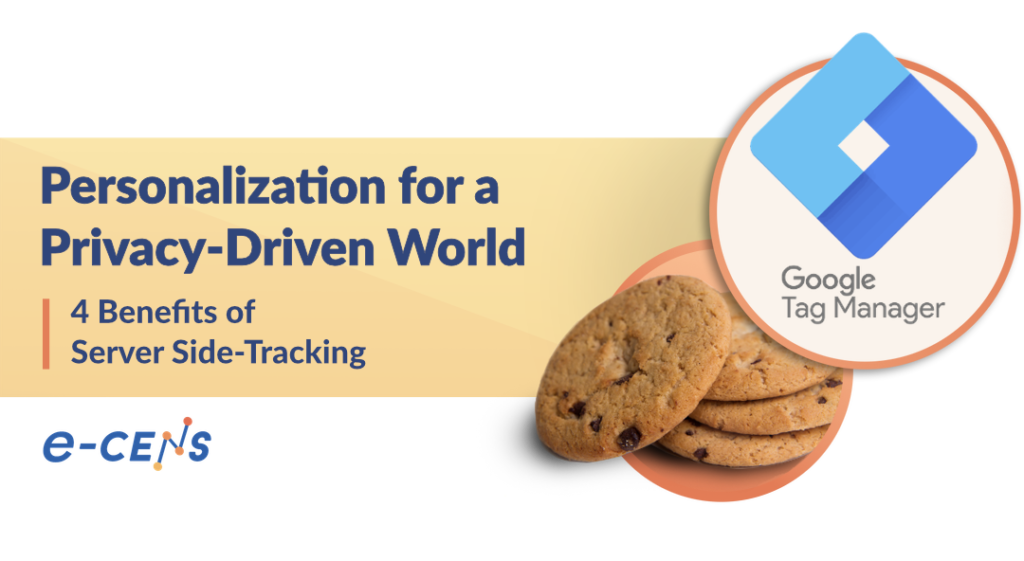Third-party cookies aren’t going away just yet, but that doesn’t mean you shouldn’t start preparing for a cookieless world.
Google will soon deliver on its plan to phase out third-party cookies from Chrome, the browser with a whopping 65% market share. In doing so, Chrome will join Apple’s Safari and Mozilla’s Firefox in deprecating cross-site tracking for good.
With third-party cookies on their way out, you need to implement alternative ways of gaining accurate data to fuel your marketing strategies. One of the substitutes worth looking into is server-side tracking. Server-side tracking is a novel way of collecting user data that lets you bypass ad blockers and improve website performance — while adhering to privacy regulations such as GDPR and CCPA. In this guide, we’ll take a look at four main benefits of server-side tagging and how it can help you future-proof your marketing analytics.

Client-side Tracking vs. Server-side Tracking
Most websites today collect user data on the client side. As the user browses the page, a JavaScript snippet fires tags according to the way you’ve configured your tracking preferences. For example, Google’s Universal Analytics snippet tracks a user’s session duration and bounce rate, among other things. It does this in the browser itself and then sends the data to google-analytics.com.
Conversely, server-side tracking runs on a separate server you own. This additional link in the data collection chain works as a proxy between the data source (your website) and the analytics tool you’re using. You benefit from increased control, as you get to choose which data is sent where. What’s more, server-side tracking lets you receive data in a first-party context, as it can be mapped to your website’s subdomain. This means you don’t have to worry about ad blockers and the browser’s native tracking protection. We’ll explore these and other key benefits in the following sections.
Benefits of Server-side Tagging
1. Prolong cookie shelf life
Safari and Firefox automatically delete cookies from your site after 7 days or 24 hours, depending on the way you’ve implemented them. Even if the cookies you’ve set are custom-built and don’t relate to a third-party service, if they’re stored in the user’s browser — they will expire. This can have a detrimental impact on your marketing activities, including attribution, personalization, and user journey analysis.
For example, you may not be able to serve personalized content to a returning user because their cookies have been deleted and your website treats them as a new user. Likewise, if a user converts several days after clicking on an ad with UTM tags, you won’t be able to attribute their conversion to that particular campaign.
Because server-side tracking uses a custom subdomain tied to your website’s domain, you can set first-party cookies that are not affected by the browser’s tracking restrictions. This way, you can configure the expiry date of the cookies yourself, setting it to, for example, 2 years.
2. Go Around Ad Blockers to Get All Your User Data
More than a third of the world’s internet users have an ad blocker installed on their browser, according to Statista. This is one of the leading causes of data collection disruption, and, consequently, it also impacts behavior tracking. Consequently, you may be missing out on large amounts of web traffic data — which means you won’t be able to make decisions based on complete and accurate data.
Ad blockers identify subdomains associated with tracking platforms and block requests directed at them. But because you can set server-side tagging on your site’s subdomain, the ad blocker can’t detect it. You can then forward the tracking data from your server to the analytics tool you’re using, making your Web Analytics more accurate.
3. Improve Website Performance
The speed at which your website loads is essential for a good user experience. Google research shows that 53% of people leave a site that takes more than 3 seconds to load on a mobile device. In addition, page speed affects SEO. This is because the time it takes for a page to load influences how high a website ranks in Google’s search results.
Tracking scripts that run on the client side can significantly slow down your site, prompting users to drop out. This, in turn, lowers your SEO score. By moving them to the cloud, you can reduce and even remove resource-heavy JavaScript code and improve your website loading speed.
4. Ensure Data Security & Compliance
As already mentioned, one of the biggest benefits of server-side tagging is the fact you have complete control over the data. This is not the case with client-side tracking, where a third-party service may be scraping users’ PII without your knowledge. Given how strict today’s privacy laws are, it’s important to ensure your sensitive user data remains safe.
In the case of server-side data collection, third-party services can’t access any data about the visitor apart from what you send them. In this setup, the analytics platform is communicating with your server and receives only the information configured in your server-side tags.
Conclusion
Server-side tracking is a new way of collecting user data without relying on third-party cookies and in-browser tags. It provides a number of benefits including complete, more accurate data, improved website performance, and regulatory compliance.
If you need support with implementing server-side analytics on your website, contact our team of experts at e-CENS and step into the next era of Digital Analytics.




